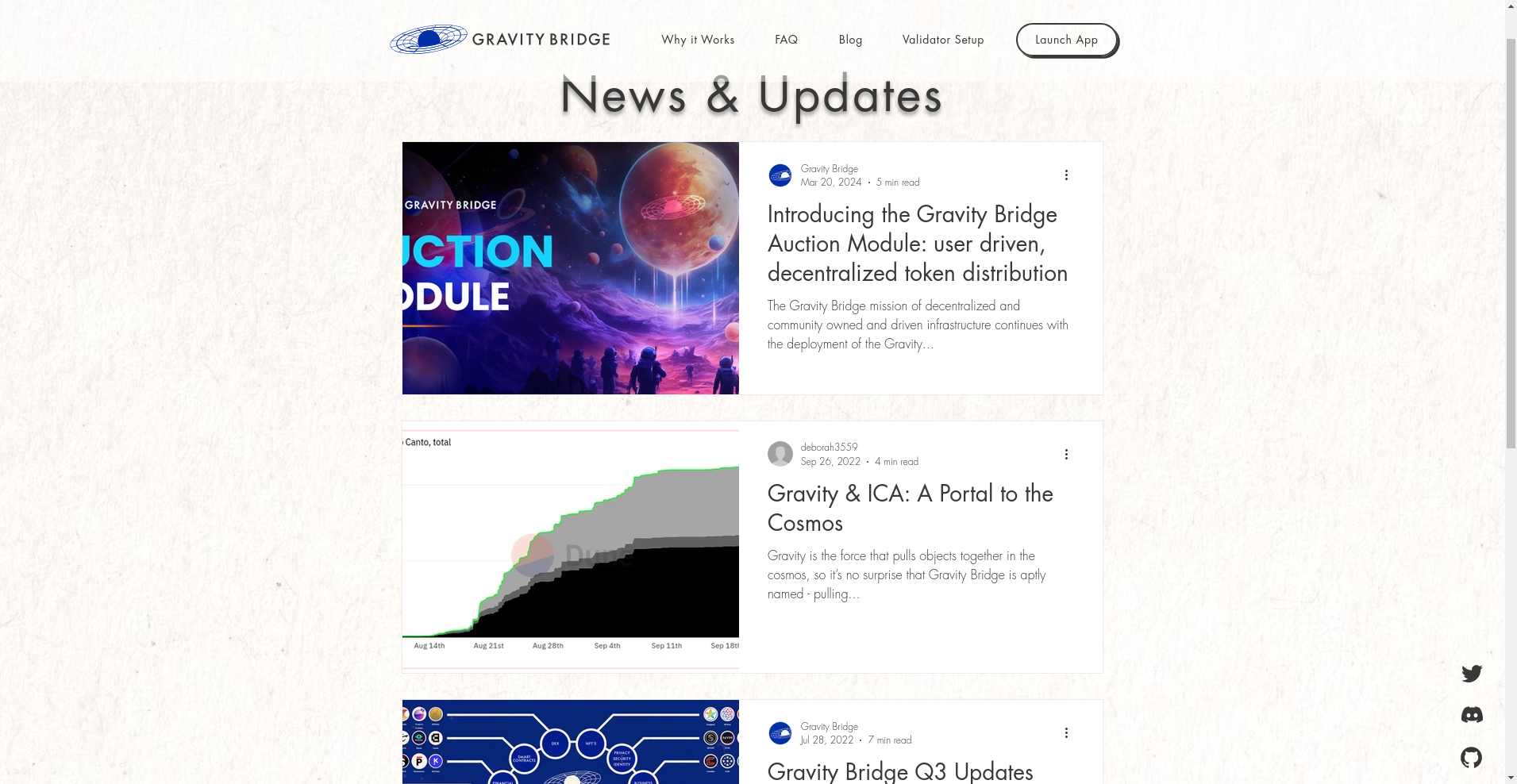Gravity Bridge ($GRAV) Review: A Data-Driven Look at Its Legitimacy, Security, and Risks

Project Overview
Gravity Bridge is an ambitious blockchain interoperability protocol designed to facilitate seamless asset transfer between the Ethereum ecosystem and the Cosmos network. Its core aim is to create a decentralized, secure, and scalable bridge that enhances liquidity and utility for assets such as ERC-20 tokens and Cosmos-native tokens like ATOM.
The project leverages the Inter-Blockchain Communication (IBC) protocol within Cosmos and combines it with Ethereum-compatible bridging mechanisms. This hybrid approach allows Gravity Bridge to act as a neutral intermediary—connecting disparate blockchains—thereby fostering cross-chain DeFi, asset fungibility, and ecosystem integration. This review sets out to provide an impartial analysis of its legitimacy, security posture, and potential risks, based solely on available data and audit reports.
Team and Roadmap Evaluation
The publicly available data does not specify detailed information about the core team behind Gravity Bridge. While the project benefits from decentralized validator participation—over 100 validators joined its mainnet at launch—there is limited transparency regarding individual team members, their backgrounds, or prior experience. This lack of explicit team credentials can influence perceptions of trustworthiness and long-term viability. Understanding the impact of anonymous teams on DeFi trust is crucial when evaluating such projects.
The project's development roadmap emphasizes continuous upgrades and ecosystem expansion. Noteworthy milestones include:
- Mainnet launch in December 2021: A decentralized event with broad validator participation indicates effort toward decentralization.
- "Polaris" Upgrade: Introduced efficiency features such as minimized validator upgrade downtime and the Ethereum key signing for easier transaction signing.
- Implementation of Interchain Accounts (ICA): Facilitates complex cross-chain interactions, enabling Cosmos chains and Ethereum to interact more seamlessly. Learn more about Interchain Accounts (ICA) in Cosmos for deeper insights.
- Community governance initiatives: Active community forums and governance proposals suggest a community-driven approach.
Overall, the roadmap reflects a focus on decentralization, user experience, and security improvements. Nonetheless, limited information about the core development team and their credentials warrants cautious optimism regarding the project's long-term ability to deliver its promises.
Security and Trust Analysis
The security evaluation for Gravity Bridge is predominantly based on the Cer.live audit report. According to the data, the project underwent a semi-formal audit process, including an audit by Code4rena—a recognized third-party auditor—plus additional assessments by Informal Systems and Least Authority. The platform's overall audit score is modest, at 5.2 out of 10, and the audit coverage is approximately 30%, indicating a preliminary or ongoing scrutiny rather than comprehensive security verification. Understanding the risks of partial crypto audits is essential in such scenarios.
Key findings from the audit include:
- Incident history: The report notes past incidents, which require further details but suggest areas for caution.
- Code vulnerabilities: Specific vulnerabilities or issues identified are not detailed in the summary, but the presence of ongoing bug bounty programs indicates an awareness of security risks and proactive mitigation efforts.
- Centralization risks: While the validator set is decentralized, the audit hints at potential points of failure or attack within the codebase.
In conclusion, the current security posture demonstrates awareness and active testing but leaves room for improvement. For potential investors or node operators, heightened due diligence is advised, especially given the partial audit coverage and moderate score. The security of cross-chain bridges is inherently complex; thus, the reliance on validator decentralization and security infrastructure must be made explicit by the project’s governance and technical measures.
Tokenomics Breakdown
The native token, $GRAV, plays a central role in governance, validator staking, and ecosystem incentives. Its economic design impacts the project's sustainability and community alignment. Adhering to tokenomics best practices is crucial for long-term viability.
- Total supply: The total supply is not explicitly specified in the accessible data, but approximately half of the tokens are allocated for community DAO discretion, including grants, liquidity programs, and airdrops.
- Distribution: Allocation appears to be split between validator rewards, community treasury, development grants, and early investors. Specific percentages are not provided, raising questions about centralization of token control.
- Vesting and lock-up: Details such as vesting schedules or lock-up periods remain unspecified, creating uncertainties about token inflation and market stability.
- Utility: Governance participation, staking to secure the network, and incentives for liquidity providers are the primary use cases.
This tokenomics model emphasizes decentralization and community involvement but may face risks from inflation if token supply is not managed carefully. The reliance on governance proposals and community discretion suggests that economic stability depends heavily on active participation and prudent management.
Ecosystem and Development Activity
Development activity for Gravity Bridge is actively ongoing. The project has undergone multiple upgrades—most notably the Polaris update—that improved performance and usability, such as enabling single-wallet interaction with cross-chain assets via Metamask integration.
In terms of ecosystem engagement, Gauge incentives such as liquidity pools on Crescent DEX and collaborations with communities like Evmos demonstrate genuine utilization. Bridging over $115 million to Canto prior to the article indicates real-world volume and demand, rather than mere marketing hype. The formation of collaborative working groups and community governance proposals further underline sustained, active development efforts. The underlying technology enabling much of this is the Cosmos IBC protocol, a key enabler of this interoperability.
However, much of the recent discourse centers around technical enhancements, community proposals, and governance structures rather than large-scale enterprise adoption. This suggests the project remains in an advanced development phase, emphasizing robust infrastructure before commercial deployment.
Reviewing the Terms and Conditions
Based on the available documentation snippets, there are no explicitly unusual or risky contractual clauses identified. The project promotes decentralization, community governance, and open-source development. The trademarks for COSMOS and GRAVITY BRIDGE are clearly registered, indicating ownership and branding protection.
Potential concerns could include the lack of detailed legal terms or clarity on dispute resolution mechanisms, especially regarding cross-chain asset custody. Additionally, the partial audit coverage might leave some legal or security gaps unaddressed.
Final Analysis: The Investment Case for Gravity Bridge
Gravity Bridge presents itself as a credible, community-driven interoperability infrastructure with a focus on decentralization and security. Its active development, recent upgrades, and real asset volume demonstrate tangible progress. Nonetheless, its security posture as reflected in the limited audit score and partial audit coverage warrants careful consideration.
Pros / Strengths:
- Decentralized validator set: Over 100 validators contribute to security and reliability. Those interested in participating can explore becoming a Gravity Bridge validator.
- Active development and upgrades: Continuous improvements enhance usability and scalability.
- Real-world asset transfers: Over $115 million bridged, indicating genuine utility.
- Strong community governance: Inclusive proposals and ecosystem support foster decentralization.
- Technical innovation: Implementation of features like IBC auto-forwarding and Metamask integration enhances user experience.
Cons / Risks:
- Partially audited security: Moderate audit score with approximately 30% coverage necessitates cautious risk management.
- Lack of transparent team data: Limited information on core developers and advisors reduces confidence in long-term delivery.
- Tokenomics uncertainties: Lack of detailed supply and vesting schedules may lead to inflation risks.
- Technical complexity: Cross-chain bridges are inherently vulnerable to exploits, especially with evolving attack vectors.
In conclusion, Gravity Bridge exhibits a promising foundation but requires ongoing security validation and transparency to effectively mitigate risks. Investors and node operators should weigh its genuine progress against the inherent complexities and unresolved vulnerabilities typical of interoperability protocols. A cautious approach is advisable until further audits and disclosures substantiate its robustness.

Daniel Clark
On-Chain Quantitative Analyst
I build algorithmic tools to scan blockchains for signals of manipulation, like whale movements and liquidity drains. I find the patterns in the noise before they hit the charts.
Similar Projects
-
Minteo
Review of Minteo: Crypto Scam Checker & Project Scam Review
-
Quidax Token
Quidax Token Review: Scam or Legit Crypto? Proven Legitimacy Check
-
CryptoGame
Crypto Project Review & Scam Checker: Is CryptoGame a Legit Investment or Scam?
-
Platypusycoin.xyz
Crypto Scam Checker Review: Is Platypusycoin.xyz a Legit Project or a Scam?
-
Chopper Inu
Crypto Project Review & Scam Checker: Is Chopper Inu a Legitimate Crypto Venture or a Rug Pull?